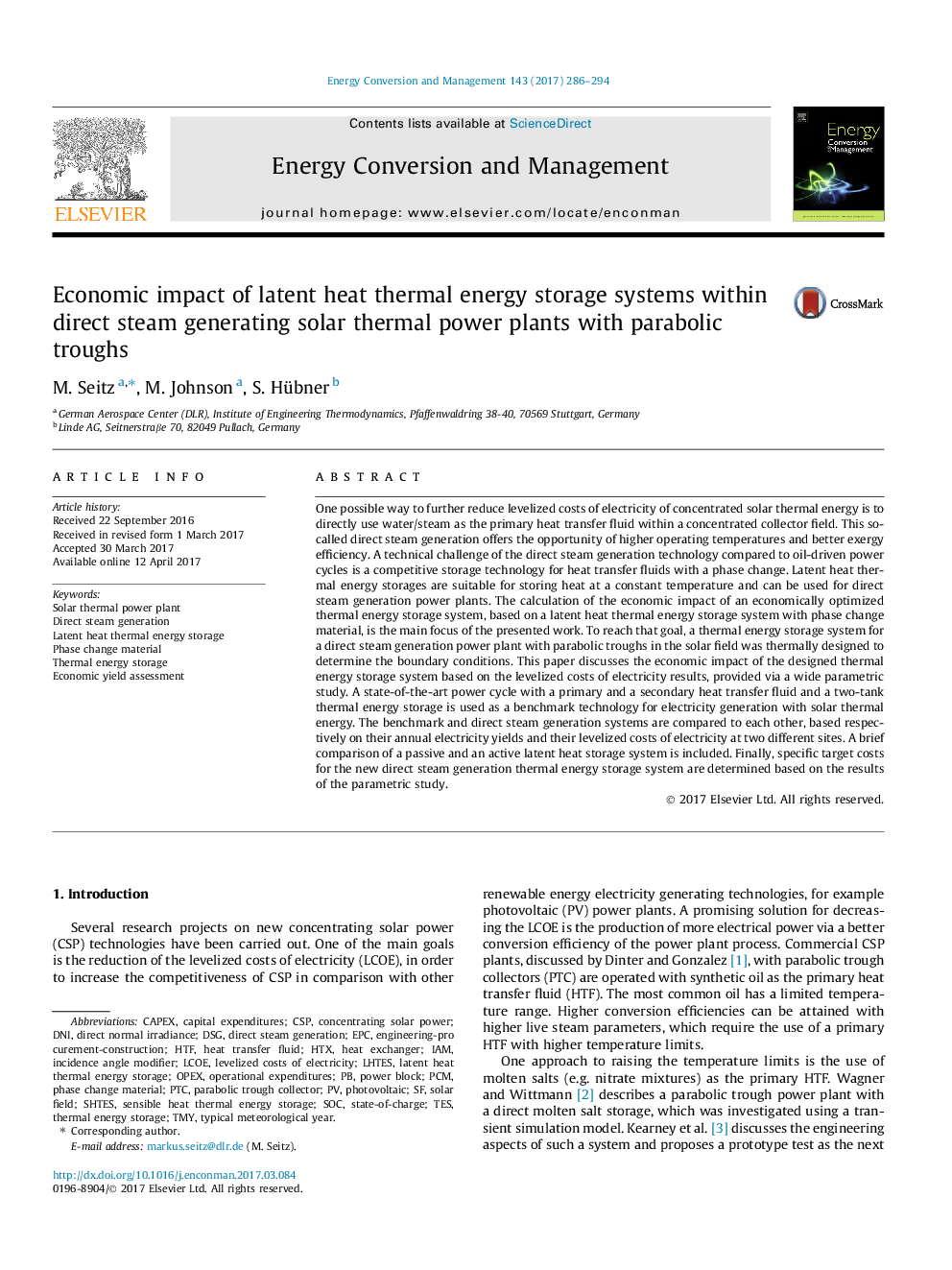| کد مقاله | کد نشریه | سال انتشار | مقاله انگلیسی | نسخه تمام متن |
|---|---|---|---|---|
| 5012775 | 1462819 | 2017 | 9 صفحه PDF | دانلود رایگان |
عنوان انگلیسی مقاله ISI
Economic impact of latent heat thermal energy storage systems within direct steam generating solar thermal power plants with parabolic troughs
ترجمه فارسی عنوان
تأثیر اقتصادی سیستم های ذخیره انرژی حرارتی پنهان در نیروگاه های حرارتی خورشیدی مستقیم با فواصل پارابولی
دانلود مقاله + سفارش ترجمه
دانلود مقاله ISI انگلیسی
رایگان برای ایرانیان
کلمات کلیدی
PTCPCMEPCLCOEOPEXCAPEXCSPDSGLHTESHTFHTx - HTXHeat transfer fluid - انتقال حرارت انتقال مایعاتpower block - بلوک قدرتdirect normal irradiance - تابش نور مستقیمDirect steam generation - تولید بخار مستقیمParabolic trough collector - جمع کننده پارابولیکlatent heat thermal energy storage - ذخیره انرژی حرارتی پنهان شدهDNI - روزConcentrating solar power - غلظت انرژی خورشیدیPhotovoltaic - فتوولتائیکHeat exchanger - مبدل گرمایی یا مبدل حرارتیIAM - من هستمPhase change material - مواد تغییر فاز دهندهSolar field - میدان خورشیدیcapital expenditures - هزینه های سرمایهOperational expenditures - هزینه های عملیاتیIncidence angle modifier - ویرایش زاویه برش
ترجمه چکیده
یکی از راه های ممکن برای کاهش بیشتر هزینه های تولید برق انرژی حرارتی متمرکز، استفاده مستقیم از بخار آب / بخار به عنوان مایع انتقال حرارت اولیه در یک میدان کلکتور متمرکز است. این بخار به اصطلاح مستقیم تولید بخار می دهد فرصت درجه حرارت بالاتر و کارایی بهتر اگزرژی را ارائه می دهد. یک چالش فنی از تکنولوژی تولید بخار مستقیم در مقایسه با چرخه های قدرت موتور، یک تکنولوژی ذخیره سازی رقابتی برای مایعات انتقال حرارت با تغییر فاز است. ذخیره سازی انرژی حرارتی خنک برای نگهداری گرما در دمای ثابت مناسب است و می تواند برای نیروگاه های تولید بخار مستقیم استفاده شود. محاسبه تأثیر اقتصادی یک سیستم ذخیره انرژی حرارتی بهینه از لحاظ اقتصادی، بر اساس یک سیستم ذخیره انرژی حرارتی پنهان با مواد تغییر فاز، تمرکز اصلی کار ارائه شده است. برای رسیدن به این هدف، یک سیستم ذخیره انرژی حرارتی برای یک نیروگاه بخار تولید مستقیم با چاه های پارابولی در منظومۀ خورشیدی، برای تعیین شرایط مرزی طراحی شده است. این مقاله در مورد تاثیر اقتصادی سیستم ذخیره سازی انرژی حرارتی طراحی شده بر اساس هزینه های تولید شده بر روی نتایج الکتریکی، که از طریق یک مطالعه پارامتری گسترده ارائه شده است، مورد بحث قرار می گیرد. یک چرخه قدرتمند پیشرفته با یک مایع انتقال حرارت اولیه و یک ثانویه و ذخیره سازی انرژی حرارتی دو مخزن به عنوان یک تکنیک معیار برای تولید برق با انرژی حرارتی خورشیدی استفاده می شود. معیار و سیستم های تولید بخار مستقیم با یکدیگر مقایسه می شوند، بر اساس تولید برق سالانه و هزینه های تولید برق در دو محل مختلف، بر اساس آنها. مقایسه ای کوتاه از یک سیستم ذخیره سازی غیر فعال و غیر فعال شامل گنجانده شده است. در نهایت، هزینه های هدف خاص برای سیستم ذخیره انرژی حرارتی تولید مستقیم بخار جدید بر اساس نتایج مطالعه پارامتری تعیین می شود.
موضوعات مرتبط
مهندسی و علوم پایه
مهندسی انرژی
انرژی (عمومی)
چکیده انگلیسی
One possible way to further reduce levelized costs of electricity of concentrated solar thermal energy is to directly use water/steam as the primary heat transfer fluid within a concentrated collector field. This so-called direct steam generation offers the opportunity of higher operating temperatures and better exergy efficiency. A technical challenge of the direct steam generation technology compared to oil-driven power cycles is a competitive storage technology for heat transfer fluids with a phase change. Latent heat thermal energy storages are suitable for storing heat at a constant temperature and can be used for direct steam generation power plants. The calculation of the economic impact of an economically optimized thermal energy storage system, based on a latent heat thermal energy storage system with phase change material, is the main focus of the presented work. To reach that goal, a thermal energy storage system for a direct steam generation power plant with parabolic troughs in the solar field was thermally designed to determine the boundary conditions. This paper discusses the economic impact of the designed thermal energy storage system based on the levelized costs of electricity results, provided via a wide parametric study. A state-of-the-art power cycle with a primary and a secondary heat transfer fluid and a two-tank thermal energy storage is used as a benchmark technology for electricity generation with solar thermal energy. The benchmark and direct steam generation systems are compared to each other, based respectively on their annual electricity yields and their levelized costs of electricity at two different sites. A brief comparison of a passive and an active latent heat storage system is included. Finally, specific target costs for the new direct steam generation thermal energy storage system are determined based on the results of the parametric study.
ناشر
Database: Elsevier - ScienceDirect (ساینس دایرکت)
Journal: Energy Conversion and Management - Volume 143, 1 July 2017, Pages 286-294
Journal: Energy Conversion and Management - Volume 143, 1 July 2017, Pages 286-294
نویسندگان
M. Seitz, M. Johnson, S. Hübner,
